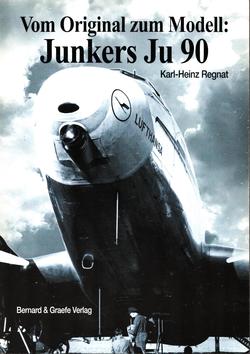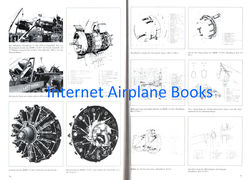JUNKERS
Ju90 LUFTHANSA 4-ENGINE AIRLINER_WW2 GERMAN LUFTWAFFE MILITARY TRANSPORT
VOM ORIGINAL ZUM MODELL SOFTBOUND BOOK
in GERMAN by KARL-HEINZ REGNAT
DEVELOPMENT AND OPERATIONS OF THE Ju90
“DER GROSSE DESSAUER” “WURTTEMBERG” “PREUSSEN”, “MECKLENBURG”, “BAYERN”,
“BADEN”
Ju90 LUFTHANSA AND LATER LUFTWAFFE
SERVICE
The Junkers Ju 90 was a 40-seat,
four-engine airliner developed for and used by Deutsche Luft Hansa shortly
before World War II. It was based on the rejected Ju 89 bomber. During the war,
the Luftwaffe impressed them as military transports.
The Junkers Ju 90 airliner and transport
series descended directly from the Junkers Ju 89, a contender in the Ural
bomber programme aimed at producing a long-range strategic bomber. This concept
was abandoned by the Reichsluftfahrtministerium (RLM, Reich Aviation Ministry)
in April 1937 in favour of smaller, faster bombers. Design was headed by Ernst
Zindel.[1] Development was headed by Professor Herbert Wagner.
Deutsche Luft Hansa put a request for a
long-distance commercial aircraft as early as 1933. When the Ju 89 program was
abandoned, the third prototype was partially completed and at the request of
Luft Hansa, it was rebuilt as an airliner, retaining the wings and tail of the
original design, but incorporating a new, wider, passenger-carrying fuselage.
The new design was designated the Ju 90.
The Junkers Ju 90[3][6][7] was a
four-engine all-metal, low-wing aircraft fitted with twin end-plate vertical
stabilizers. The wings were built around five tubular girder spars covered with
a smooth stressed skin. The leading edge was quite markedly swept, the trailing
edge almost straight. The Junkers "double wing", a full-span movable
flap/aileron combination, was fitted. The tail units on the prototypes used the
traditional Junkers corrugated skin, the only part of the aircraft to do so,
abandoning the exposed corrugated skinning on later Ju 90 production models for
the Luftwaffe. The fins and rudders, the latter with prominent horn balances
assemblies, were placed at the end of the tailplane; this latter carried the
elevators separated by a gap, forming another double wing. These components
were as used in the Ju 89.
The new fuselage was of oval
cross-section, covered by stressed smooth duralumin skin. On the first four Ju
90As, five pairs of rectangular windows were on each side, each double pair
lighting a divided-off section of the cabin containing eight seats in facing
pairs on either side of a central aisle. The Ju 90B, whose prototypes were the
Ju 90 V5 through the Ju 90 V10 aircraft, adopted round fuselage portholes. The
Ju 90 V11 became the definitive Ju 290 prototype with smaller, rectangular
fuselage windows.
The Ju 90B series were visually
distinctive because of their oval tail fins. The Ju 90 V6 was withdrawn from
test flights, and rebuilt as the Ju 390 V1 prototype. The Ju 90 V9 was also
withdrawn and rebuilt as the Ju 390V2, later redesignated in October 1944 as
the Ju 390A-1. The Ju 90 V10's rebuild into the Ju 390 V3 bomber prototype was
commenced, but was scrapped at the factory in June 1944. The Junkers firm was
paid compensation for seven Ju 390s under construction, when Ju 390 orders were
cancelled.
The plane had four or five divided
fuselage sections, the latter holding the maximum of 40 passengers. Toilets, a
cloakroom and a mail store were placed aft, and a baggage hold was forward of
the passenger space. The fuselage was generous by the standards of the time
with an internal width of 2.83 m (9 ft 3½ in).
The tailwheel undercarriage was fully
retractable, with the single-wheel main units raising hydraulically into the
inner engine nacelles.
The first prototype, the Ju 90 V1, was
powered by four Daimler-Benz DB 600C liquid-cooled inverted V engines
delivering 820 kW (1,100 hp) each. These were more powerful than both those of
its Ju 89 predecessor and of production commercial Ju 90s. Named Der Grosse
Dessauer as had been the earlier Junkers G 38, its maiden flight took place on
28 August 1937. Deutsche Luft Hansa carried out the long-distance testing.
After eight months of flight tests, this prototype broke up on 6 February 1938
during over-speed tests.
A second prototype (V2) was delivered
to Luft Hansa in May 1938 for testing. Like all the production commercial Ju
90s, this was powered by four BMW 132 radial engines delivering 620 kW (830
hp). The move to lower power was probably necessitated by the demands on
Daimler Benz to produce engines for strategically important, frontline
aircraft.[5] They named this aircraft Preussen. It crashed fatally during
tropical flight tests on takeoff in November 1938 at Bathurst, Gambia, probably
because of engine failure.
Despite these setbacks, Luft Hansa
ordered eight of the production type A-1s. They also used the next two
prototypes, starting with V3 Bayern which flew on the Berlin-Vienna route from
July 1938. This aircraft flew a total of 62,572 km ( mi) in 1938.[5] Only seven
of the A-1s were delivered to Luft Hansa, the last in April 1940, one going
directly to the Luftwaffe.
South African Airways also ordered two
A-1s with Pratt & Whitney Twin Wasp engines delivering 670 kW (900 hp).
These were known by the alternative designation Z-3 to distinguish them from
the BMW-powered Z-2. Neither of these was delivered to SAA, but went instead to
the Luftwaffe. As the war progressed, the surviving six Luft Hansa airframes
were also impressed into Luftwaffe service, though two were returned to Luft
Hansa later. Four of these aircraft took part in the invasion of Norway.
The fourth prototype V4 went into
Luftwaffe service in July 1941 fitted with 980 kW (1,320 hp) Jumo 211F/L
engines.
In April 1939, the RLM asked Junkers
for a further development of the Ju 90 for military transport purposes.[3][7]
The Ju 90V5 and V6 were the prototypes of this military design. They got a new
wing with a straight inner section leading edge, of greater span (19%) and area
(11%). The landing gear was strengthened with twin main wheels and the fins
were more rounded, lacking the characteristic horn balance nick of the earlier
models. The windows were replaced by 10 small portholes a side. The Ju 90 V5
flew first on 5 December 1939. A special feature of both the V5 and V6 was a
powered boarding ramp in the floor of the rear section of the fuselage for
loading cars and larger cargo freight.[7][9] This Trapoklappe ramp, when
lowered, was powerful enough to raise the fuselage to the horizontal flying
position. Both aircraft were retroactively fitted with the much more powerful,
unitized Kraftei-mount 1,200 kW (1,600 hp) BMW 801MA radials, with the first
suffix letter "M" signifying the initial Motoranlage format of
unitized powerplant installation design promulgated by the RLM. Ju 90s were
also used as tugs for heavy gliders.
The two last prototypes – the V7 and V8
– fed directly into the Ju 290 development programme. The former had a fuselage
extension of 1.98 m (6 ft 6 in) and the addition of dihedral to the tailplane
to solve a yaw instability. A reconnaissance prototype aerodynamically similar
to the V7, the V8 was armed, however, with two 20 mm MG 151/20 cannons and up
to nine 13 mm (.51 in) MG 131 machine guns in two dorsal, one ventral, and one
tail position.






